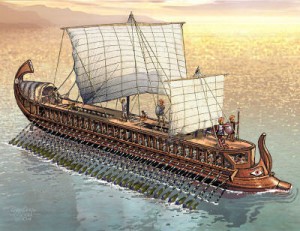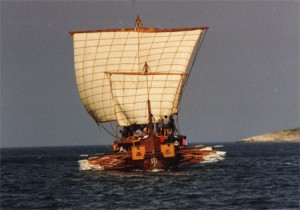Greek Trireme Warship Facts
First used in the 8th Century BC, the Greek trireme was a state-of-the-art military machine. Fast and agile, triremes were designed to exert maximum power during military engagements.
Both the Greeks and the Phoenicians employed these ships for military and trading purposes – its name is derived from its ability to seat three levels of rowers who were positioned on both sides of the vessel. Greek triremes played an essential role in the Persian wars becoming an important symbol of Athenian military capability. By the 5th Century BC these ships came to dominate the waters around the eastern Mediterranean.
Construction of the triremes began with the hull. Later, the builders added wooden ribs in order to strengthen the vessel, these were reinforced with ropes that were fitted to the keel and stretched tightly over the timber. The ships were built with soft woods – namely pine and fir – while larch was employed for the interior of the vessel, the keel was made of oak.
The crew of Greek trireme consisted of 200 men, this included rowers, a marine corp (comprising archers and spearmen) andadeck crew who were under the command of the helmsman. Due to its design the trireme was meant to undertake short, swift operations. At night, the ships would pull into harbour where the crew would collect fresh water and store it for the next stage of the journey.
 Primary propulsion came from the oarsmen, this included one man per oar. While the ship was designed with two masts, its steering was actually controlled by two large paddles that were positioned at the stern. It is believed that the trireme could sail at six to eight knots; the distance it travelled depended entirely on the weather and its overall manpower. In favourable conditions, it was thought that the oarsmen were able to propel the ship 50 or 60 miles over a seven-hour period.
Primary propulsion came from the oarsmen, this included one man per oar. While the ship was designed with two masts, its steering was actually controlled by two large paddles that were positioned at the stern. It is believed that the trireme could sail at six to eight knots; the distance it travelled depended entirely on the weather and its overall manpower. In favourable conditions, it was thought that the oarsmen were able to propel the ship 50 or 60 miles over a seven-hour period.
The oarsmen
Rowers consisted not of slaves but of free men and hired foreigners. The oarsmen were divided into three groups. The thranitai occupied the top section of the ship – a position that was relatively comfortable in comparison with conditions below. However, added strength and agility was required of these men.
The middle section of Greek trireme, who were known as the zygitai, rowed directly beneath the thranitai although at a slightly different angle, while the lowest set of rowers, the thalamitai, were seated in dismal surroundings at the bottom of the ship. The heat here was intense. The oarsmen were particularly vulnerable during enemy engagement and if the rowers were captured, the enemy would dismember their thumbs or cut off their hands. Moreover, if they were trapped below deck during a hostile encounter they risked drowning.
![Ultimate Fighting Machine Ultimate Fighting Machine]() Battle tactics of Greek trireme
Battle tactics of Greek trireme
Athenian military operations depended on their close-quarters battle tactics, namely the ramming and boarding of enemy ships. The ram of the trireme was built at the front of the ship creating a large metal horn. When the ship attacked it would come in from the stern and attempt to rupture the hull of the enemy ship. A small number of marines were placed on the deck of the ship.
They would defend or attack, attempting to board the enemy vessel armed with shields, spears and archery equipment. A squadron of triremes employed a wide range of battle tactics, these included a manoeuvre that was designed to outflank and encircle the enemy before attacking the rear of their ship.


